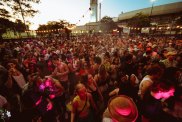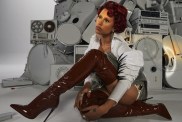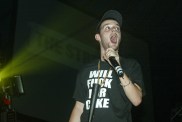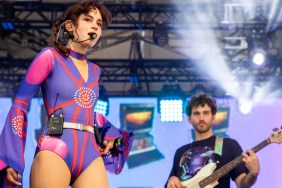Beneath the Eyrie is the seventh Pixies album and the third to arrive during the band’s second phase as a relentless-touring, festival-headlining entity. Between 1988 and 1991, the Boston band released four records that are widely regarded as having changed the face of indie rock music.
Accompanying each new Pixies album is a weight of baggage brought along by people who’ve been fans for 30 years. Critics tend to analyse everything through the lens of those first four records, which led to some rather salty reviews for 2014’s Indie Cindy and 2016’s Head Carrier. The band seems largely unfazed, however, as does their continually-expanding global following.
Unlike its two predecessors, Beneath the Eyrie was recorded in the USA, at Dreamland Recording Studios in Hurley, New York. Royal Blood producer Tom Dalgety was retained from Head Carrier and it’s the second album to feature bass player Paz Lenchantin.
Original bass player Kim Deal was in attendance for the 2004 reunion but departed in 2013 to focus on The Breeders. Deal is an enormously loved figure, which has no doubt placed a huge amount pressure on Lenchantin, but for singer-songwriter Charles Thompson (aka Black Francis), guitarist Joey Santiago, and drummer David Lovering, intra-band synergy is as strong as it ever was.
Pixies are coming to Australia next March for the Come On Pilgrim… It’s Surfer Rosa tour. Music Feeds spoke to Santiago about the new record, the changing band dynamics and upcoming tour.
Music Feeds: The last three records haven’t come in as quick succession as the first four, but each new Pixies album feels like a bonus – for many years it felt like the band’s recording days were over. Within the band is there a push to keep working on new stuff?
Joey Santiago: Charles is itching to record all the time, but now we are at pace with normal bands who record records. It wasn’t really that normal to release an album every year. I don’t think many artists do an album a year. Some of them wait five years. We leave the studio and it’s like, “All right when’s the next time? That was great.”
MF: How do you feel in relation to the external narrative of the band when you’re working on a new record – are you paying attention to how much the Pixies means to people and the level of scrutiny the new album will be subjected to?
JS: We’re mostly concerned about does the song suck? Can we save it? Is it worth the effort to work on this? Usually, the case is, “absolutely!” That’s our main concern, the structure of the song, song by song, bar by bar, note by note, snare drum hit by snare drum hit. “Does that snare sound good? Oh god, it got loose. We’ve got to tighten it back up.” That’s our main concern. “Is that the right microphone? Is this the right amp? Is this the right guitar?”
MF: Critics are quick to compare your new releases to the first four records. Are you able to ignore that pressure?
JS: We’re not like grabbing a Les Paul and thinking, “Does Rolling Stone want this guitar on the album? Oh, no Pitchfork is really fucking picky, what should we do for them?” We don’t think like that. No one thinks like that. If they do, they’re probably going to make a shitty record.
MF: Beneath the Eyrie was recorded at Dreamland Recording Studio with Tom Dalgety once again producing. How would you characterise the recording of this album in contrast to earlier Pixies records?
JS: I don’t know how many songs were put together in the studio, fresh – I think there were four or five – so it would stand to reason that we were gelling, we really were on stride creatively. The producer already had 12 songs in mind. We already had the material to record an album and consequently, four or five songs were tossed out of that original demo.
So you can deduct that we were a band that could work together without any stress and without any egos in the way to put together the new songs. We were communicating.
MF: This is the second album to feature Paz on bass. She officially joined in 2016 and made a creative contribution to Beneath the Eyrie. Has the dynamic changed much since she entered the picture?
JS: It’s different. It’s got a different vibe than we had before. Obviously the difference is positive. Paz has definitely contributed to injecting joy into the creative process.
MF: Pixies albums aren’t po-faced or impenetrably solemn, but there is a sense that you’re very serious about your work and that a feeling of tension would mark the recording sessions. Is the injection of joy into the creative process a novelty?
JS: Back in the latter albums that we were recording as the Pixies, pre-breakup, it got uncomfortable. From Bossanova and Trompe le Monde, the only communication we had was people would come in – Charles would come in, listen to a guitar part, he goes, “oh that’s great [or] nope, gotta do it again.” And I was like, “ok, oh fine.”
You go into the studio: “what did he say? What do people think about this?” And I’d say, “well we’ve gotta kind of change it.” And that person was hardly around, but now people are around. There’s an easier line of communication.
MF: The album is preceded by information about you entering a rehab facility in 2016 to deal with problems relating to alcohol abuse. Did that have a tangible impact on your contributions to this record?
JS: My thought process is better. I dealt with external stuff better. Studio-wise I really never had a problem in it. It wasn’t like, “Is he going to show up?” I was never like that. It was more the way I dealt with the problems outside. My thinking was really, really screwed up. I didn’t know that until I entered rehab. It was like, “Oh fuck, man.” My thoughts were haunted.
MF: Pixies albums have always been textually layered, incorporating macabre imagery, Spanish language and immersive storytelling. Do you keep learning things about Pixies songs long after they’ve been written and recorded?
JS: It’s different being a band member than a journalist and a fan. It’s more compartmentalised for me. Paz, the producer and Charles would flesh out the lyrics and stuff. I don’t see why I would put my hands on the steering wheel. I have my own set of work to do, which is guitar parts or textures. So lyrically, it’s like a private moment. It’s not my job. I’m not the brother that’s going to go into my brother’s diary.
Sometimes [Charles explains it to me]. Sometimes he gets excited about a subject and says, “Listen to this. Oh my god, it’s about this stuff.” Other times there’s no explanation. This time around he does explain it and I go, “Holy shit, really? It’s about that? I had it all wrong.”
MF: You’re coming to Australia to perform Come On Pilgrim and Surfer Rosa in full. They’re now over 30 years old and a lot has changed for Pixies in that time. Your setlists always include songs from these records. How do you keep them feeling fresh and exciting?
JS: There’s more history to go on now. There’s more things we could draw on, experiences to draw on. We take it now, like, “Oh I did this before. Nah, it’s time to do something new.” We have the past to draw on, but we’re always in the moment anyway. What is the song? What does it serve? What do we do with it? It’s more in the moment, like back then was in the moment.
–
‘Beneath the Eyrie’ is out now. Listen here. Pixies will tour Australia in March 2020. Head here for tour info.












